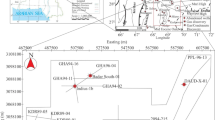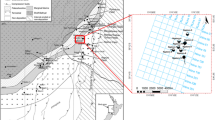Abstract
This work offers a new insight into the structural architecture and 3D representation of Qishn sandstone reservoir along Sharyoof field which is located at Say’un–Masilah basin in Hadramawt Province, Yemen. The 3D representation depends mainly on the integration of wireline logging data with 2D seismic lines along the Sharyoof field. The workflow of this study includes the interpretation of well logging data, tying the well data with the horizons along the 2D seismic lines, and manual interpretations for the seismic data to construct time structure contour maps. The check shot data was used to construct a velocity model which used to convert the resultant maps from time to depth. Finally, results were integrated to construct a 3D structural model for the Sharyoof field. The depths of 4 main formations tops (Fartaq, Harshiyat, Qishn, and Sa’ar formations) and their members were determined by the well logging data based on their lithological content. Seismic interpretation shows 6 main gentle dipping, planer, normal faults of NE–SW affecting the pre and syn depositional formation. Some of these faults extend to shallow depths affecting the post-rift Tertiary formations. The structural architecture of the Sharyoof field is mainly affected by the Early Cretaceous rifting between the African–Arabian and Madagascar–Indian which leads to the reactivation of the Najd fault system and the initiation of these NE–SW normal faults. The increase of the hydrocarbon productivity along the Sharyoof field requires drilling a new development well which suggested being north–east the current wells, as the hydrocarbon potentiality is mainly concentrated along this area.












Similar content being viewed by others
Availability of data and material
Not applicable.
Code availability
Not applicable.
References
Abdelmaksoud A, Amin AT, El-Habaak GH, Ewida HF (2019) Facies and petrophysical modeling of the Upper Bahariya Member in Abu Gharadig oil and gas field, north Western Desert, Egypt. J African Earth Sci 149:503–516. https://doi.org/10.1016/J.JAFREARSCI.2018.09.011
Ahlbrandt TS (2002) Madbi Amran/Qishn total petroleum system of the Ma′Rib–Al Jawf/Shabwah, and Masilah-Jeza basins, Yemen. USGS Bull 33
Al-Areeq NM (2008) Sedimentological evolution and petroleum system in the central part of Sayun-Masilah Basin, Republic Of Yemen. Faculty of Science, Assiut University
Al-Areeq NM, Elhossainy MM, Salman AM (2020) Sequence stratigraphic architecture of the Upper Jurassic-Lower Cretaceous deposits in the Sayun-Masilah Basin, Yemen: a case study from Masilah oilfields. J Asian Earth Sci 192. https://doi.org/10.1016/j.jseaes.2020.104287
Al-Areeq NM, Maky AF, Abu-Elata AS et al (2019) Comprehensive study on the conventional petroleum system of the Masilah oilfields, Sayun-Masilah Basin, Yemen. J Pet Sci Eng 181:106193. https://doi.org/10.1016/J.PETROL.2019.106193
Al-Chalabi M (1997) Time-depth relationships for multilayer depth conversion. Geophys Prospect 45:715–720. https://doi.org/10.1046/j.1365-2478.1997.520293.x
Al-Johi A, Ibrahim E, Al Faifi HJ et al (2019) Investigating deep geological reservoirs using seismic reflection and well logs, Tawila oil field, Yemen: implications for structural setting and reservoir properties. J Pet Sci Eng 176:1018–1040. https://doi.org/10.1016/j.petrol.2019.02.020
Al-Matary AM, Ahmed HM (2011) Basin analysis study of block 10 in the Say’un-Masilah Basin, Yemen, using a 1D backstripping method. Arab J Geosci 2011 53 5:529–543. 10.1007/S12517-011-0280-0
Alareeq N (2008) Sedimentological evolution and petroleum system in the central part of Sayun-Masila Basin, Republic of Yemen. Faculty of Science-Assiut University
Amaru M, Hoelting C, Ivanova N, Osypov K (2017) Introduction to this special section: velocity-model uncertainty. 36:126. https://doi.org/10.1190/TLE36020126.1
Al-Areeq NM, Soliman MA, Essa MA, Al-Azazi NA (2016) Diagenesis and reservoir quality analysis in the Lower Cretaceous Qishn sandstones from Masila oilfields in the Sayun–Masila Basin, eastern Yemen. Geol J 51:405–420. https://doi.org/10.1002/GJ.2639
As-Saruri M, Sorkhabi R (2014) Petroleum systems and basins of Yemen. In: AAPG Memoir. AAPG Special Volumes, pp 757–780
As-Saruri MA, Sorkhabi R, Baraba R (2013) Sedimentary basins of Yemen: their tectonic development and lithostratigraphic cover. Front Earth Sci 5:361–373. https://doi.org/10.1007/978-3-642-30609-9_18
As-Saruri MA, Sorkhabi R, Baraba R (2010) Sedimentary basins of Yemen: their tectonic development and lithostratigraphic cover. Arab J Geosci 3:515–527. https://doi.org/10.1007/s12517-010-0189-z
Barakat M, Dominik W (2010) Seismic studies on the Messinian rocks in the onshore Nile Delta, Egypt. 72nd Eur Assoc Geosci Eng Conf Exhib 2010 A New Spring Geosci Inc SPE Eur 2010 7:cp-161-00770. 10.3997/2214-4609.201401362
Barakat MK, El-Gendy NH, El-Bastawesy MA (2019) Structural modeling of the Alam EL-Bueib Formation in the jade oil field, Western Desert, Egypt. J African Earth Sci 156:168–177. https://doi.org/10.1016/J.JAFREARSCI.2019.05.003
Beydoun ZR (1966) Geology of the Arabian Peninsula Protectorate and part of Dhufar. US Geol Surv Prof Pap 560-H:56. https://doi.org/10.3133/PP560H
Beydoun ZR, As-Saruri MA, El-Nakhal H, et al (1998) International lexicon of stratigraphy, Volume III, Republic of Yemen, Second Edition. Republic of Yemen Publication International Union of Geological Sciences and Ministry of Oil and Mineral Resources
Beydoun ZR, As-Saruri ML (1998) Phanerozoic depositional basins and inter-basinal highs of Yemen: their structural framework and sedimentary cover. Zeitschrift für Geol Wissenschaften 26:517–529
Beydoun ZR, As-Saruri ML, Baraba RS (1996) Sedimentary basins of the Republic of Yemen: their structural evolution and geological characteristics. Rev l’Institut Français du Pétrole 51:763–775. https://doi.org/10.2516/OGST:1996049
Beydoun ZR, Bamahmoud MO, Nani ASO (1993) The Qishn Formation, Yemen: lithofacies and hydrocarbon habitat. Mar Pet Geol 10:364–372. https://doi.org/10.1016/0264-8172(93)90081-3
Brannan J, Sahota G, Gerdes DK, Al-Berry J (1999) Geological evolution of the central Marib-Shabwa Basin, Yemen. GeoArabia 4:9–34
Cameron M, Fomel S, Sethian J (2006) Seismic velocity estimation and time to depth conversion of time-migrated images. SEG Tech Progr Expand Abstr 25:3066–3070. https://doi.org/10.1190/1.2370164
Chopra S, Marfurt KJ (2005) Seismic attributes - a historical perspective. Geophysics 70:3SO–28SO
Csató I, Habib A, Kiss K et al (2001) Play concepts of oil exploration in Yemen: MOL’s experience in 1996-2000. Oil Gas J 99:68–74
Davison I, Tatnell M, Owen L, et al (1998) Tectonic geomorphology and rates of crustal processes along the Red Sea margin, north-west Yemen. In: In: Purser BH, Bosence DWJ (eds) Sedimentation and tectonics in rift Basins: Red Sea−Gulf of Aden. Chapman and Hall, London, pp 595–612
DNO (2003) Annual report 2003
Duchesne MJ, Gaillot P (2011) Did you smooth your well logs the right way for seismic interpretation? J Geophys Eng 8:514–523. https://doi.org/10.1088/1742-2132/8/4/004
Elmahdy M, Tarabees E, Bakr A, Farag AE (2020a) Polygonal faults in Eocene carbonate reservoir, Abu El-Gharadig Basin, Egypt. Geol J 55:4670–4680. https://doi.org/10.1002/GJ.3708
Elmahdy M, Tarabees E, Farag AE, Bakr A (2020b) An integrated structural and stratigraphic characterization of the Apollonia carbonate reservoir, Abu El-Gharadig Basin, Western Desert, Egypt. J Nat Gas Sci Eng 78:103317. https://doi.org/10.1016/J.JNGSE.2020.103317
Etris E, Crabtree N, Dewar J (2001) True depth conversion: more than a pretty picture. CSEG Rec 11–21
Giraud A, Thouvenot F, Huber R (1986) Macroseismicity microseismicity. 22:247–255
Haitham FMS, Nani ASO (1990) The Gulf of Aden rift: hydrocarbon potential of the Arabian sector†. J Pet Geol 13:211–220. https://doi.org/10.1111/j.1747-5457.1990.tb00840.x
Hakimi MH, Abdullah WH, Shalaby MR (2011) Organic geochemical characteristics and depositional environments of the Jurassic shales in the Masila Basin of Eastern Yemen. GeoArabia 16:47–64
Hakimi MH, Al-Sufi SA (2018) Organic geochemistry investigations of crude oils from Bayoot oilfield in the Masila Basin, east Yemen and their implication for origin of organic matter and source-related type. Egypt J Pet 27:37–54. https://doi.org/10.1016/j.ejpe.2017.01.001
Hakimi MH, Al-Sufi SA, Al-Hamadi S, Al-Sharabi SA (2015) Petrophysical analysis of early cretaceous Saar carbonates from Sharyoof oilfield in the Masila Basin, eastern Yemen, and their impact on reservoir properties and quality. Arab J Geosci 8:11307–11319. https://doi.org/10.1007/s12517-015-1972-7
Haq BU, Al-Qahtani AM (2005) Phanerozoic cycles of sea-level change on the Arabian Platform. GeoArabia 10:127–160
Hubral P (1977) Time migration—some ray theoretical aspects*. Geophys Prospect 25:738–745. https://doi.org/10.1111/J.1365-2478.1977.TB01200.X
Husseini MI (1989) Tectonic and deposition model of Late Precambrian–Cambrian Arabian and adjoining plates. Am Assoc Pet Geol Bull 73:1117–1131
JUNGWIRTH J, As-Saruri M (1990) Structural evolution of the platform cover on southern Arabian Peninsula (P. D. R. Yemen). Zeitschrift für Geol Wissenschaften 18:505–514
Khamis M, Bin ME, Al Natifi A et al (2017) Simulation of the mulltizones clastic reservoir: a case study of Upper Qishn Clastic Member, Masila Basin–Yemen. J African Earth Sci 130:252–268. https://doi.org/10.1016/j.jafrearsci.2017.03.018
King WA, Mills BR, Gardiner S, Abdillah AA (2003) The Masila fields. Republic of Yemen. AAPG Mem:275–295. https://doi.org/10.1306/M78834C16
Lashin A, Bin ME, Khamis M (2016) Characterization of the Qishn sandstone reservoir, Masila Basin-Yemen, using an integrated petrophysical and seismic structural approach. J African Earth Sci 115:121–142. https://doi.org/10.1016/j.jafrearsci.2015.11.026
Leckie DA, Rumpel T (2003) Tide-influenced sedimentation in a rift basin—Cretaceous Qishn Formation, Masila Block, Yemen: a billion barrel oil field. Am Assoc Pet Geol Bull 87:987–1013. https://doi.org/10.1306/01220301116
Meisingset I, Hubred J, Krasova D (2018) High quality regional velocity modelling for depth conversion. 1st EAGE/PESGB Work Veloc 2018-Febru. 10.3997/2214-4609.201800009
Mills SJ (1993) Oil discoveries in the Hadramaut; how Canadian Oxy scored in Yemen. Oil Gas J 90:49–52
Moore JM (1979) United States Department of the Interior Geological Survey Saudi Arabian Mission Primary and secondary faulting in the Najd fault system, Kingdom of Saudi Arabia
Morton MQ (2013) Oil exploration in Yemen history of oil. GeoExPro 102:68–72
Mott-Smith M (1939) On seismic paths and velocity-time relations. Geophysics 4:8–23. https://doi.org/10.1190/1.1440484
Mountain GS, Prell WL (1990) A multiphase plate tectonic history of the southeast continental margin of Oman. Geol Soc Spec Publ 49:725–743. https://doi.org/10.1144/GSL.SP.1992.049.01.44
Ogbamikhumi A, Aderibigbe OT (2019) Velocity modelling and depth conversion uncertainty analysis of onshore reservoirs in the Niger Delta basin. J Cameroon Acad Sci 14:239. https://doi.org/10.4314/jcas.v14i3.7
Omran AA, Alareeq NM (2014) Log-derived petrophysical characteristics and oil potentiality of the Upper Qishn Clastic Member, Masila Basin, Yemen. Arab J Geosci 7:1733–1748. https://doi.org/10.1007/s12517-013-0871-z
Redfern P, Jones JA (1995) The interior rifts of the Yemen - analysis of basin structure and stratigraphy in a regional plate tectonic context. Basin Res 7:337–356. https://doi.org/10.1111/j.1365-2117.1995.tb00121.x
Sachsenhofer RF, Bechtel A, Dellmour RW et al (2012) Upper Jurassic source rocks in the Sab’atayn Basin, Yemen: depositional environment, source potential and hydrocarbon generation. GeoArabia 17:161–186
Seaborne TR (1996) The influence of the Sabatayn Evaporites on the hydrocarbon prospectivity of the Eastern Shabwa Basin, Onshore Yemen. Mar Pet Geol 13:963–972. https://doi.org/10.1016/S0264-8172(96)00017-7
Shelander D, Smith V, Leetaru H, Will R, Couëslan M (2014) The evolution and effect of the velocity model on various aspects of surface seismic data analysis. Energy Procedia 63:4374–4384. https://doi.org/10.1016/j.egypro.2014.11.472
Tyson S (2007) An introduction to reservoir modelling. Piper’s Ash Ltd., Chippenham
White R, Simm R (2003) Tutorial: good practice in well ties. First Break 21:75–83. https://doi.org/10.3997/1365-2397.21.10.25640
White RE (1980) Partial coherence matching of synthetic seismograms with seismic traces*. Geophys Prospect 28:333–358. https://doi.org/10.1111/J.1365-2478.1980.TB01230.X
White RE, Hu T (1998) How accurate can a well tie be? Lead Edge (Tulsa, OK) 17:1065. https://doi.org/10.1190/1.1438091
Acknowledgements
The authors thank the Data Bank Development project in Yemen for supporting this work with the required data through. They gratefully acknowledge Mrs. Sarah El-Nadi for her English revision and the reviewers whose comments helped to strengthen this manuscript.
Funding
Not applicable.
Author information
Authors and Affiliations
Corresponding author
Ethics declarations
Conflict of interest
The authors declare that they have no competing interests.
Additional information
Responsible Editor: François Roure
Highlights
• Integration of seismic and well data for the reservoir characterization of the Qishn reservoir at Sharyoof field.
• 3D structural modeling of the Sharyoof field.
• Improvement of the hydrocarbon production from the Qishn Formation along the Sharyoof field.
Rights and permissions
About this article
Cite this article
Abdullah, E.A., Al-Areeq, N.M., Elmahdy, M. et al. A new insight into the structural architecture of Sharyoof field, Say’un–Masilah basin, Yemen. Arab J Geosci 14, 1977 (2021). https://doi.org/10.1007/s12517-021-08299-2
Received:
Accepted:
Published:
DOI: https://doi.org/10.1007/s12517-021-08299-2




